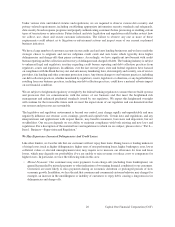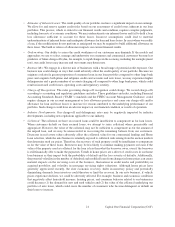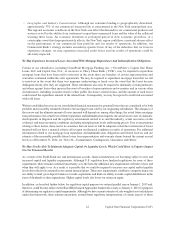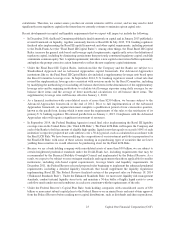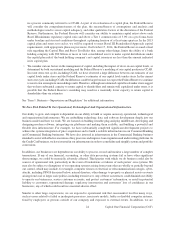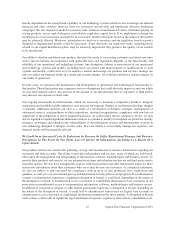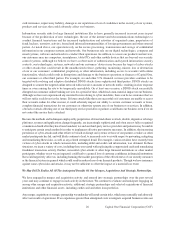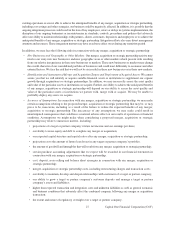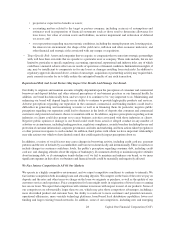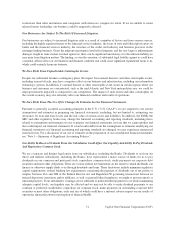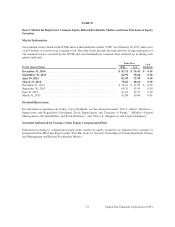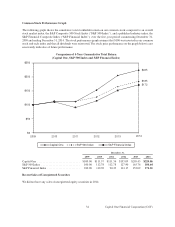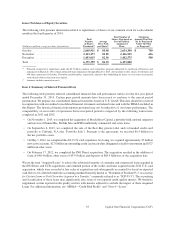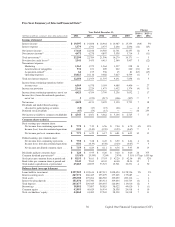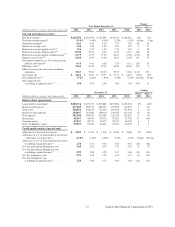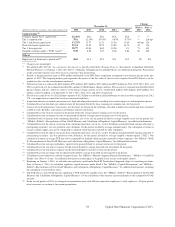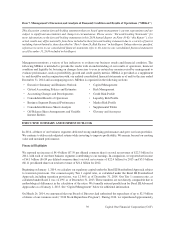Capital One 2014 Annual Report Download - page 52
Download and view the complete annual report
Please find page 52 of the 2014 Capital One annual report below. You can navigate through the pages in the report by either clicking on the pages listed below, or by using the keyword search tool below to find specific information within the annual report.large part on our capacity to invest in and build the technology platforms that can enable them. We continue to actively
invest in such technology platforms, however, we may fail to implement the correct technology, or may fail to do so in
a timely manner as discussed in more detail below under the heading “We Face Risk Related To Our Operational,
Technological And Organizational Infrastructure.” As noted above, some of our competitors are substantially larger
than we are, which may allow those competitors to invest more money into their technology infrastructure and digital
innovation than we do. In addition, we face intense competition from smaller companies which experience lower cost
structures and different regulatory requirements than we do, and which may allow them to innovate more rapidly than
we can. Further, our success depends on our ability to attract and retain strong digital and technology leaders, engineers
and other talent, and competition for such talent is intense. If we are unable to attract and retain digital and technology
talent, our ability to offer digital products and services and build the necessary technology infrastructure could be
negatively affected, which could negatively impact our business and financial results. A failure to maintain or enhance
our competitive position with respect to digital products and services, whether because we fail to anticipate customer
expectations or because our technological developments fail to perform as desired or are not implemented in a timely
or successful manner, could negatively impact our business and financial results.
Fluctuations In Market Interest Rates Or Volatility In The Capital Markets Could Adversely Affect Our Revenue
And Expense, The Value Of Assets And Obligations, Our Cost Of Capital Or Our Liquidity.
Like other financial institutions, our business may be sensitive to market interest rate movement and the
performance of the capital markets. Changes in interest rates or in valuations in the debt or equity markets could
directly impact us. For example, we borrow money from other institutions and depositors, which we use to make
loans to customers and invest in debt securities and other earning assets. We earn interest on these loans and assets
and pay interest on the money we borrow from institutions and depositors. Fluctuations in interest rates, including
changes in the relationship between short-term rates and long-term rates and in the relationship between our funding
basis rate and our lending basis rate, may have negative impacts on our net interest income and therefore our
earnings. In addition, interest rate fluctuations and competitor responses to those changes may affect the rate of
customer prepayments for mortgage, auto and other term loans and may affect the balances customers carry on
their credit cards. These changes can reduce the overall yield on our earning asset portfolio. Changes in interest
rates and competitor responses to these changes may also impact customer decisions to maintain balances in the
deposit accounts they have with us. In addition, changes in valuations in the debt and equity markets could have a
negative impact on the assets we hold in our investment portfolio. Such market changes could also have a negative
impact on the valuation of assets for which we provide servicing. Finally, the Final Rule requires that most amounts
reported in Accumulated Other Comprehensive Income (“AOCI”), including unrealized gains and losses on
securities designated as available for sale, be included in our regulatory capital calculations. Changes in interest
rates or market valuations that result in unrealized losses on components of AOCI could therefore impact our
regulatory capital ratios negatively.
We assess our interest rate risk by estimating the effect on our earnings under various scenarios that differ based on
assumptions about the direction and the magnitude of interest rate changes. We take risk mitigation actions based
on those assessments. We face the risk that changes in interest rates could materially reduce our net interest income
and our earnings, especially if actual conditions turn out to be materially different than those we assumed. See
“MD&A—Market Risk Management” for additional information.
Our Business Could Be Negatively Affected If We Are Unable To Attract, Retain And Motivate Skilled Senior
Leaders.
Our success depends, in large part, on our ability to retain key senior leaders, and competition for such senior leaders
is intense. The executive compensation provisions of the Dodd-Frank Act and the regulations issued thereunder, and
any further legislation, regulation or regulatory guidance restricting executive compensation, may limit the types of
compensation arrangements that we may enter into with our most senior leaders and could have a negative impact on
our ability to attract, retain and motivate such leaders in support of our long-term strategy. These laws and
regulations may not apply in the same manner to all financial institutions, and we therefore may face more
30 Capital One Financial Corporation (COF)


